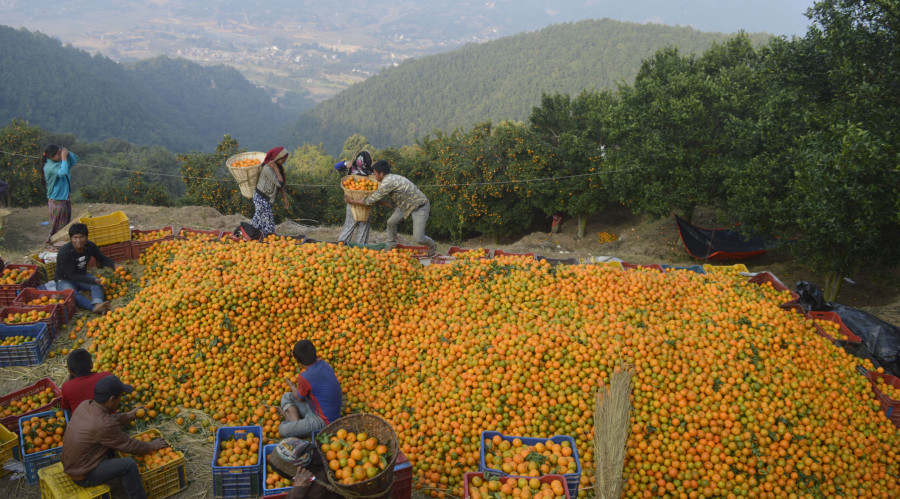Money
Nepal’s economy on road to recovery, economists say
As per the World Bank, the country is expected to achieve a growth rate of 2.7 percent this fiscal year.
Sangam Prasain
In the last fiscal year 2019-20 ended mid-July, Nepal suffered the first economic contraction in 37 years as Covid-19 related social distancing measures and lockdowns paralysed the country.
A slow recovery in the ongoing fiscal year 2020-21 is expected to boost the growth rate to 2.7 percent, backed by a favourable monsoon and an optimistic outlook that the Covid-19 related disruptions will fade and government relief spending will materialise, a World Bank report released on Wednesday said.
As per the report entitled South Asia Economic Focus Spring 2021: South Asia Vaccinates, Nepal would recover gradually and achieve a growth rate of 3.9 percent in 2021-22 and then 5.1 percent by 2022-23, based on the baseline projections of a successful domestic and global vaccination rollout and a gradual resumption of international tourism, which is expected to fully recover after two years.
“There is a risk that political uncertainty, if prolonged, may undermine investment sentiment,” the report said.
Another uncertainty in the way of faster recovery of the Nepali economy is the new waves of Covid-19 infections in neighbouring India.
“Sources of risk to the outlook include possible new waves of Covid-19, as well as increased political uncertainties, following the dissolution of Parliament’s lower house in December 2020 and the Supreme Court’s February 2021 decision to reinstate it,” said the report which included activities till March 25, 2021.
The government is yet to review the growth forecast it had made initially.
Even though the Nepali economy was clearly heading towards a catastrophe as the months-long lockdown brought life to a standstill, confounding experts who struggled to make plausible predictions, the then finance minister Yuba Raj Khatiwada had set a highly ambitious growth target of 7 percent.
Nepal imposed a complete lockdown on March 24, a decision the government made after finding only the second Covid case in the country.
“It’s still uncertain. But given that Nepal will not witness the new waves of Covid-19 infections, and consumption and demand increases, we have roughly projected Nepal’s economic growth rate at 5 percent for this fiscal year,” said Hem Raj Regmi, deputy director general of the Central Bureau of Statistics.
“It’s mainly led by a growth in the agriculture sector, which contributes 27 percent to the national economy.”
According to Regmi, the manufacturing and service sectors will see a gradual recovery because of the subdued demand. “Our economy is on track,” he said.
“A 5 percent growth sounds more reasonable to me,” said economist Biswo Poudel.
“Except for transport and hospitality, the construction and manufacturing industries have revived. Imports and tax collection have returned to normal, and it’s a sign that the economy is getting back on track,” Poudel told the Post.
Last week, Nepal eased travel rules removing the quarantine requirement for foreign tourists. Economists say that the move will help the country’s tourism to recover to some extent.
But the World Bank has warned that the new variants of the virus could thwart Nepal's plans to gradually open up to tourism.
According to the Central Bureau of Statistics, in the fourth quarter of the last fiscal year 2019-20, the country’s economic growth rate, or output of the gross domestic product, plunged 15.4 percent compared to the same period in 2018-19, which resulted in a year-on-year negative growth rate of 1.99 percent.
The annual growth rate went into negative territory for the first time in 37 years. In 1982-83, Nepal’s economic growth rate had sunk to -2.97 percent, according to World Bank data.
This was the seventh negative growth rate Nepal had seen since the then Ministry of Economic Planning started compiling the National Accounts Statistics in 1961-62.
According to the World Bank, industrial activities are likely to remain below pre-pandemic levels until early 2022-23.
Nepal’s growth averaged 4.9 percent over the fiscal years 2008-09 to 2018-19, supported by remittance inflows but constrained by structural vulnerabilities and periodic shocks.
Natural disasters, such as the April 2015 earthquake and recurring floods and landslides, and external developments, such as border closures, trade disruptions and the recent pandemic, depressed growth and impacted livelihoods, the report said.
While the lockdown impacted all sectors of the economy, they disproportionately affected workers engaged in subsistence activities, who make up over half of the country's workforce.
International border restrictions and economic downturns abroad also forced thousands of Nepali migrants to return home, elevating the risk that many households who have relied on remittances and informal sector jobs may fall back into poverty.
A nationwide lockdown from March-July 2020 impacted economic activity in the last four months of 2019-20. As a result, output contracted by an estimated 1.9 percent in the last fiscal year. Wholesale and retail trade, tourism, transport and associated services such as hotels and restaurants—which are all important drivers of growth—were particularly impacted.
The World Bank said that in the first half of fiscal 2020-21 (mid-July 2020 to mid-January 2021), growth remained sluggish, given that tourism stalled and private investment was constrained by risk aversion and uncertainty.
However, there were incipient signs of recovery in wholesale and retail trade, transport and financial services, as containment measures were gradually eased. Subdued demand and adequate food supply brought year-on-year consumer price inflation to a three-year low of 3.7 percent, the report said.
Given modest levels of foreign direct investment, external concessional loans financed the current account deficit. Official foreign exchange reserves reached $11.3 billion by mid-January 2021—equivalent to 11.3 months of imports.
A recent World Bank Covid monitoring survey suggests that the pandemic-related economic slowdown had a major impact on jobs and incomes, with more than two in five economically active workers reporting a job loss or prolonged work absence in 2020.




 15.76°C Kathmandu
15.76°C Kathmandu















